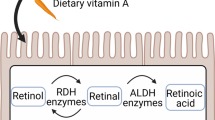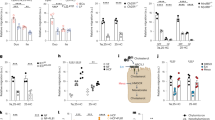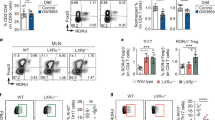Abstract
Lactoferrin (LF) and retinoic acid (RA) are enriched in colostrum, milk, and mucosal tissues. We recently showed that LF-induced IgA class switching through binding to betaglycan (transforming growth factor-beta receptor III, TβRIII) and activation of canonical TGF-β signaling. We investigated the combined effect of LF and RA on the overall IgA response. An increase in IgA production by LF was further augmented by RA. This combination effect was also evident in Ig germ-line α (GLα) transcription and GLα promoter activity, indicating that LF in cooperation with RA increased IgA isotype switching. We subsequently found that RA enhanced TβRIII expression and that this increase contributed to LF-stimulated IgA production. In addition to the IgA response, LF and RA in combination also enhanced the expression of the gut-homing molecules C-C chemokine receptor 9 (CCR9) and α4β7 on B cells. Finally, peroral administration of LF and RA enhanced the frequency of CCR9+IgA+ plasma cells in the lamina propria. Taken together, these results suggest that LF in cooperation with RA can contribute to the establishment of gut IgA responses.
This is a preview of subscription content, access via your institution
Access options
Subscribe to this journal
Receive 12 digital issues and online access to articles
$119.00 per year
only $9.92 per issue
Buy this article
- Purchase on Springer Link
- Instant access to full article PDF
Prices may be subject to local taxes which are calculated during checkout





Similar content being viewed by others
References
Lamm ME . Interaction of antigens and antibodies at mucosal surfaces. Annu Rev Microbiol 1997; 51: 311–340.
Hamann A, Andrew DP, Jablonski-Westrich D, Holzmann B, Butcher EC . Role of alpha 4-integrins in lymphocyte homing to mucosal tissues in vivo. J Immunol 1994; 152: 3282–3293.
Pabst O, Ohl L, Wendland M, Wurbel MA, Kremmer E, Malissen B et al. Chemokine receptor CCR9 contributes to the localization of plasma cells to the small intestine. J Exp Med 2004; 199: 411–416.
Wagner N, Lohler J, Kunkel EJ, Ley K, Leung E, Krissansen G et al. Critical role for beta7 integrins in formation of the gut-associated lymphoid tissue. Nature 1996; 382: 366–370.
Stavnezer J . Molecular processes that regulate class switching. Curr Top Microbiol Immunol 2000; 245: 127–168.
Coffman RL, Lebman DA, Shrader B . Transforming growth factor beta specifically enhances IgA production by lipopolysaccharide-stimulated murine B lymphocytes. J Exp Med 1989; 170: 1039–1044.
Kim PH, Kagnoff MF . Transforming growth factor-beta 1 is a costimulator for IgA production. J Immunol 1990; 144: 3411–3416.
Sonoda E, Matsumoto R, Hitoshi Y, Ishii T, Sugimoto M, Araki S et al. Transforming growth factor beta induces IgA production and acts additively with interleukin 5 for IgA production. J Exp Med 1989; 170: 1415–1420.
Chambon P . A decade of molecular biology of retinoic acid receptors. FASEB J 1996; 10: 940–954.
Tokuyama Y, Tokuyama H . Retinoids as Ig isotype-switch modulators. The role of retinoids in directing isotype switching to IgA and IgG1 (IgE) in association with IL-4 and IL-5. Cell Immunol 1996; 170: 230–234.
Tokuyama H, Tokuyama Y . Retinoic acid induces the expression of germ-line C alpha transcript mainly by a TGF-beta-independent mechanism. Cell Immunol 1997; 176: 14–21.
Mora JR, Iwata M, Eksteen B, Song SY, Junt T, Senman B et al. Generation of gut-homing IgA-secreting B cells by intestinal dendritic cells. Science 2006; 314: 1157–1160.
Seo GY, Jang YS, Kim HA, Lee MR, Park MH, Park SR et al. Retinoic acid, acting as a highly specific IgA isotype switch factor, cooperates with TGF-β1 to enhance the overall IgA response. J Leukoc Biol 2013; 94: 325–335.
Lonnerdal B . Nutritional roles of lactoferrin. Curr Opin Clin Nutr Metab Care 2009; 12: 293–297.
Legrand D, Elass E, Carpentier M, Mazurier J . Interactions of lactoferrin with cells involved in immune function. Biochem Cell Biol 2006; 84: 282–290.
Puddu P, Valenti P, Gessani S . Immunomodulatory effects of lactoferrin on antigen presenting cells. Biochimie 2009; 91: 11–18.
Bilandzic M, Stenvers KL . Betaglycan: a multifunctional accessory. Mol Cell Endocrinol 2011; 339: 180–189.
López-Casillas F, Wrana JL, Massagué J . Betaglycan presents ligand to the TGF beta signaling receptor. Cell 1993; 73: 1435–1444.
Jang YS, Seo GY, Lee JM, Seo HY, Han HJ, Kim SJ et al. Lactoferrin causes IgA and IgG2b isotype switching through betaglycan binding and activation of canonical TGF-β signaling. Mucosal Immunol 2015; 8: 906–917.
Iigo M, Alexander DB, Long N, Xu J, Fukamachi K, Futakuchi M et al. Anticarcinogenesis pathways activated by bovine lactoferrin in the murine small intestine. Biochimie 2009; 91: 86–101.
Park M-H, Park S-R, Lee M-R, Kim Y-H, Kim P-H . Retinoic acid induces expression of Ig germ line α transcript, an IgA isotype switching indicative, through retinoic acid receptor. Genes Genomics 2011; 33: 83–88.
Park SR, Lee JH, Kim PH . Smad3 and Smad4 mediate transforming growth factor-beta1-induced IgA expression in murine B lymphocytes. Eur J Immunol 2001; 31: 1706–1715.
Pardali E, Xie XQ, Tsapogas P, Itoh S, Arvanitidis K, Heldin CH et al. Smad and AML proteins synergistically confer transforming growth factor beta1 responsiveness to human germ-line IgA genes. J Biol Chem 2000; 275: 3552–3560.
Kim PH, Kagnoff MF . Transforming growth factor beta 1 increases IgA isotype switching at the clonal level. J Immunol 1990; 145: 3773–3778.
Li SC, Rothman PB, Zhang J, Chan C, Hirsh D, Alt FW . Expression of I mu-C gamma hybrid germline transcripts subsequent to immunoglobulin heavy chain class switching. Int Immunol 1994; 6: 491–497.
Muramatsu M, Kinoshita K, Fagarasan S, Yamada S, Shinkai Y, Honjo T . Class switch recombination and hypermutation require activation-induced cytidine deaminase (AID), a potential RNA editing enzyme. Cell 2000; 102: 553–563.
Seo GY, Jang YS, Kim J, Choe J, Han HJ, Lee JM et al. Retinoic acid acts as a selective human IgA switch factor. Hum Immunol 2014; 75: 923–929.
Lopez-Casillas F, Riquelme C, Perez-Kato Y, Ponce-Castaneda MV, Osses N, Esparza-Lopez J et al. Betaglycan expression is transcriptionally up-regulated during skeletal muscle differentiation. Cloning of murine betaglycan gene promoter and its modulation by MyoD, retinoic acid, and transforming growth factor-beta. J Biol Chem 2003; 278: 382–390.
Iwata M, Hirakiyama A, Eshima Y, Kagechika H, Kato C, Song SY . Retinoic acid imprints gut-homing specificity on T cells. Immunity 2004; 21: 527–538.
Rivera-Munoz P, Soulas-Sprauel P, Le Guyader G, Abramowski V, Bruneau S, Fischer A et al. Reduced immunoglobulin class switch recombination in the absence of Artemis. Blood 2009; 114: 3601–3609.
Ballard KD, Mah E, Guo Y, Pei R, Volek JS, Bruno RS . Low-fat milk ingestion prevents postprandial hyperglycemia-mediated impairments in vascular endothelial function in obese individuals with metabolic syndrome. J Nutr 2013; 143: 1602–1610.
Acknowledgements
This work was supported by a National Research Foundation of Korea (NRF) grant funded by the Korean government (MEST) (2010-0012311 to Pyeung-Hyeun Kim and 2013R1A1A2057931 to Goo-Young Seo) and the second stage of the Brain Korea 21 program. Studies were conducted at the Institute of Bioscience and Biotechnology at Kangwon National University.
Author information
Authors and Affiliations
Ethics declarations
Competing interests
The authors declare no conflicts of interest.
Additional information
Supplementary information accompanies the paper on Cellular & Molecular Immunology website: http://www.nature.com/cmi.
Supplementary information
Rights and permissions
About this article
Cite this article
Lee, JM., Jang, YS., Jin, BR. et al. Retinoic acid enhances lactoferrin-induced IgA responses by increasing betaglycan expression. Cell Mol Immunol 13, 862–870 (2016). https://doi.org/10.1038/cmi.2015.73
Revised:
Accepted:
Published:
Issue Date:
DOI: https://doi.org/10.1038/cmi.2015.73
Keywords
This article is cited by
-
Early-Life Intervention of Lactoferrin and Probiotic in Suckling Piglets: Effects on Immunoglobulins, Intestinal Integrity, and Neonatal Mortality
Probiotics and Antimicrobial Proteins (2023)
-
The role of retinoic acid in the production of immunoglobulin A
Mucosal Immunology (2022)



